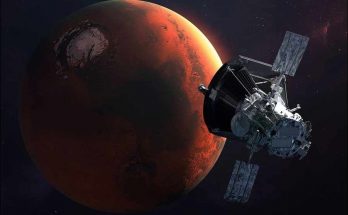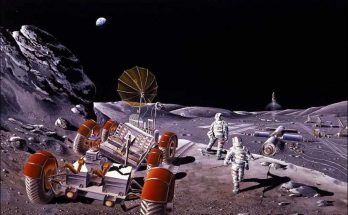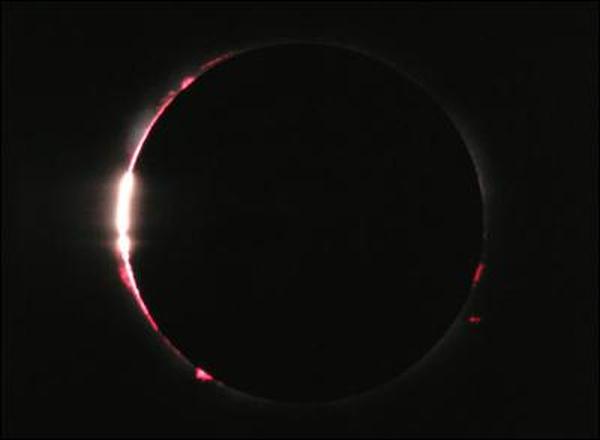Skywatchers will have a view of one of nature’s most beautiful spectacles if the weather is clear.
For a few hours on the night of Dec. 20 to Dec. 21, the attention of tens of millions of people will be drawn skyward, where the mottled, coppery globe of our moon will hang completely immersed in the long, tapering cone of shadow cast out into space by our Earth. If the weather is clear, favorably placed skywatchers will have a view of one of nature’s most beautiful spectacles: a total eclipse of the moon.
Unlike a total eclipse of the sun, which is only visible to those in the path of totality, eclipses of the moon can usually be observed from one’s own backyard. The passage of the moon through the Earth’s shadow is equally visible from all places within the hemisphere where the moon is above the horizon.
The total phase of the upcoming event will be visible across all of North and South America, as well as the northern and western part of Europe, and a small part of northeast Asia, including Korea and much of Japan. Totality will also be visible in its entirety from the North Island of New Zealand and Hawaii — a potential viewing audience of about 1.5 billion people. This will be the first opportunity from any place on earth to see the moon undergo a total eclipse in 34 months. [Amazing photos of a total lunar eclipse]
This star chart shows where in the sky the upcoming lunar eclipse will appear. And check this NASA lunar eclipse chart to see how visible the eclipse will be from different regions around the world.
Stages of the eclipse
There is nothing complicated about viewing this celestial spectacle. Unlike an eclipse of the sun, which necessitates special viewing precautions in order to avoid eye damage, an eclipse of the moon is perfectly safe to watch. All you’ll need to watch are your eyes, but binoculars or a telescope will give a much nicer view.
The eclipse will actually begin when the moon enters the faint outer portion, or penumbra, of the Earth’s shadow a little over an hour before it begins moving into the umbra. The penumbra, however, is all but invisible to the eye until the moon becomes deeply immersed in it. Sharp-eyed viewers may get their first glimpse of the penumbra as a faint smudge on the left part of the moon’s disk at or around 6:15 UT (on Dec. 21) which corresponds to 1:15 a.m. Eastern Time or 10:15 p.m. Pacific Time (on Dec. 20).
The most noticeable part of this eclipse will come when the moon begins to enter the Earth’s dark inner shadow (called the umbra). A small scallop of darkness will begin to appear on the moon’s left edge at 6:33 UT (on Dec. 21) corresponding to 1:33 a.m. EST or 10:33 p.m. PST (on Dec. 20).
The moon is expected to take 3 hours and 28 minutes to pass completely through the umbra.
The total phase of the eclipse will last 72 minutes beginning at 7:41 UT (on Dec. 21), corresponding to 2:41 a.m. EST or 11:41 p.m. PST (on Dec. 20).
At the moment of mid-totality (8:17 UT/3:17 a.m. EST/12:17 a.m. PST), the moon will stand directly overhead from a point in the North Pacific Ocean about 800 miles (1,300 km) west of La Paz, Mexico.
The moon will pass entirely out of the Earth’s umbra at 10:01 UT/5:01 a.m. EST/2:01 a.m. PST and the last evidence of the penumbra should vanish about 15 or 20 minutes later.
Color and brightness in question
During totality, although the moon will be entirely immersed in the Earth’s shadow, it likely will not disappear from sight. Rather, it should appear to turn a coppery red color, a change caused by the Earth’s atmosphere bending or refracting sunlight into the shadow.
Since the Earth’s shadow is cone-shaped and extends out into space for about 844,000 miles (1,358,000 km), sunlight will be strained through a sort of “double sunset,” all around the rim of the Earth, into its shadow and then onto the moon.
However, because of the recent eruptions of the Eyjafjallajkull volcano last spring and the Merapi volcano in Indonesia in October, one and possibly even two clouds of ash and dust might be floating high above the Earth. As a result, the moon may appear darker than usual during this eclipse; during totality, parts of the moon might even become black and invisible.
Views: 388





